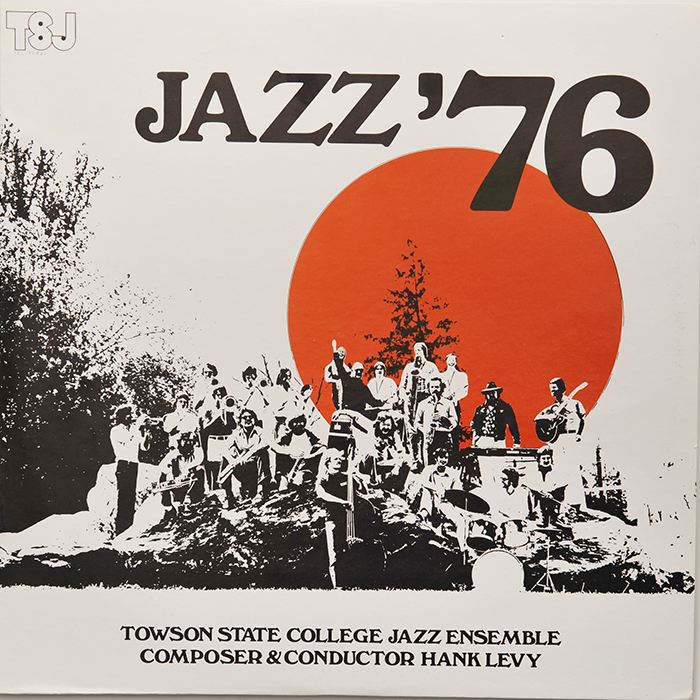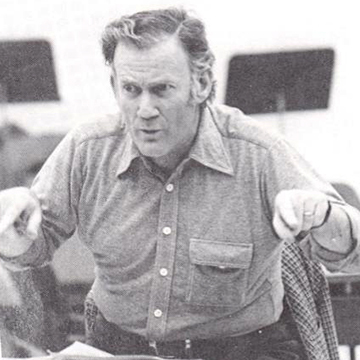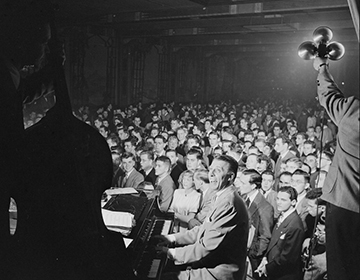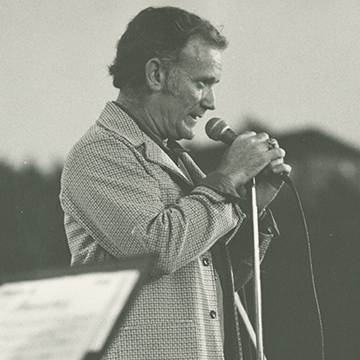
Jazz ’76
Towson State College Jazz Ensemble: Composer and Conductor Hank Levy

Henry J. (Hank) Levy was the director of jazz studies at Towson University for over twenty years. Hank’s passion was for his music and teaching his students how to perform at the highest level. While his compositions have been recorded by jazz greats — the Stan Kenton Band, Don Ellis, Sal Salvatore — Hank’s greatest pleasure was bringing a newly written chart to his Towson University students to have them work out the musical hiccups.
A true pioneer in the use of unconventional time signatures, Hank’s music and the performances of his Towson University students, took the jazz world by storm and won multiple jazz festivals. The true measure of his brilliance was the number of students who attended Towson University (Towson State College / University) during those days just to learn from him and play in one of his jazz ensembles.
Hank’s living legacy is the continual love and respect former students and fans show his music. He remains a major influence in the lives and careers of his students, several of whom are resident artists at The John F. Kennedy Center for the Performing Arts in Washington, D.C.
The legacy of Hank Levy is an important chapter in the impressive history of the College of Fine Arts and Communication (COFAC). COFAC is pleased to share Hank’s musical legacy with our friends and supporters in the Towson University community and beyond.
Former music student and current political science professor, Tony Campbell, remembers the legacy of Hank Levy in this audio podcast. Find out more information on Hank’s music, the Hank Levy Legacy Band and the Hank Levy Jazz Foundation at Hank Levy Jazz. (Transcript)
Hank Levy came of age in the 1940s, when big bands crisscrossed the country playing one-nighters for dancers who regularly attended nightclubs and ballrooms.
A Baltimore native, Hank graduated from Baltimore City College where he led his first band. Though he would attend several colleges — Catholic University, the College of William and Mary — Hank didn't receive a university degree until he arrived at Towson State College in 1968, where he was required to earn his degree in order to teach.
“ He was extraordinarily talented. He turned jazz music right around when he started working with time changes. Our band members had to relearn how to play’s Hank’s music – they liked Hank personally, but they’d groan when he’d show up for rehearsal. ”

In 1953, Hank played baritone saxophone in the legendary Stan Kenton Orchestra. Anxious to return to Baltimore, and to soon-to-be wife (of thirty years) Gloria Hildebrand, Hank would only stay six months with Kenton. Although his time with the orchestra was brief, Levy recalled that it was “equivalent to three years in college.” In the Kenton band, Hank wrote charts experimenting with odd time signatures, which Stan began to use in rehearsals. Audrey Kenton (Stan’s wife) explained the effect that Hank’s challenging music had on the Kenton band:
“He was extraordinarily talented. He turned jazz music right around when he started working with time changes. Our band members had to relearn how to play Hank’s music — they liked Hank personally, but they’d groan when he’d show up for rehearsal.”

In 1953, jazz seldom ventured outside common time (four beats per measure) or the occasional waltz time (three beats per measure). Some six years later Dave Brubeck would release the highly successful “Time Out” album. Many consider “Time Out” to be a watershed jazz recording for odd time signatures, featuring compositions “Take Five” (5/4) and “Blue Rondo à la Turk” (9/8). But Hank composed in time signatures that ventured way outside even these challenging meters. He was interested in giving jazz “a kick in the rear end” by using odd meters (5/4, 7/4, 9/4 and 13/8) and employing unusual harmonies and voicing. While difficult to master, musicians would attest that his music was rewarding to play.
One such musician was 1960s Westcoast trumpeter/bandleader Don Ellis who was also experimenting with new rhythms. One of the tunes that helped the Ellis band tear up the 1966 Monterey Jazz Festival was Hank Levy's “Passacaglia and Fugue.”
Hank would later write a number of large scale compositions, including his “Opus for Overextended Jazz Ensemble,” which was premiered by the Baltimore Symphony Orchestra in 1971.
In 1968, Hank became the jazz program director at Towson State College. Hank’s dream was to build a college jazz program that music students could attend if they were serious about big band jazz. Levy spent the 1970s and 1980s building this band. The Towson State College Jazz Ensemble won so many competitions in the early 1970s at the prestigious Quinnipiac Jazz Festival that it was ultimately barred from competing.
Watch this short video where Hank explains how the Towson State Jazz Ensemble opened the Kennedy Center in Washington D.C. and made their first recording.
View more videos from the documentary, A Head of Time, Ahead of Time (YouTube).
In 1972, the ensemble put out the first of several albums with material written and arranged by Levy. Hank's excitement about the band is summed up in this 1973 quote from an article in “Baltimore Magazine”: “I’d like to keep directing the ensemble for the rest of my life.” The compositions were so good that several of them were recorded by the Ellis and Kenton bands. Though the Towson State group lacked the soloist depth of the professional organizations it compensated with a crisp, powerhouse delivery. Many of the players ended up playing in the bands of Kenton and Ellis, beneficiaries not just of Levy's writing talent but of an offhand teaching style that charmed his students.
Hank was a master teacher who was able to get the most of his musically proficient students in a fatherly style. The polar opposite of the psychologically punishing style seen in the character of Fletcher in the film “Whiplash,” which featured Hank’s chart of the same name.
From the 1976 Towson State College Jazz Ensemble, Pegasus was also recorded by the Stan Kenton Band on the “Journey Into Capricorn” album as well as the World Champion Blue Devils Drum and Bugle Corps. Written in 6/8, it features lush harmonies from the sax section and a marvelous flugelhorn solo.
From the 1979 Towson State University Jazz Ensemble, Chain Reaction was also recorded by the Don Ellis Orchestra on the “Connection” album as well as the World Champion Blue Devils Drum and Bugle Corps. Written in 13/8, it features saxes doubling on flutes, a trumpet solo, an extended piano solo and layered harmonies by the trumpet and trombone sections.
From the 1981 Towson State University Jazz Ensemble, The Way You Look Tonight is an adaptation of a show tune standard by Jerome Kern which receives a once over from Hank’s arranging skills to present an up tempo version featuring an extended trumpet solo with a call and response with the sax section.
From the 1985 Towson State University Jazz Ensemble, one of the few original Levy charts written in 4/4. Mucho Gusto, Los Medanos features tenor sax and trumpet solos with a driving Latin inspired brass section. About halfway through an intriguing duo takes place between the drummer and trumpets / trombones playing in rhythmic unison. The rhythm section takes center stage as guitar and piano take turns soloing through the last third of the chart.
From the 1991 Towson State University Jazz Ensemble, originally written in 1947 for a film of the same name, it was not until Miles Davis recorded it a decade later that the jazz standard was established. In 4/4, On Green Dolphin Street starts with a piano prologue, transfers to the sax and trumpet section sharing the melodic lifting until the alto solo takes over. A synchronized sax section seamlessly leads the band into the apex of the chart before ending with the rhythm section, one trumpet, the sax section and one final bass guitar note.
Hank’s musical legacy moved beyond the classroom into some of the most prestigious organizations: the Walt Disney Corporation, the Kenton and Ellis bands, the U.S. Army Jazz Ambassadors.
In 1997, the United States Army Field Band Jazz Ambassadors recorded the album, “The Legacy of Hank Levy.” A video documentary on his life and work, “A Head of Time: Ahead of Time,” was completed in 2000, made by Audio Visual Artist's Productions which videotaped Hank working with the Jazz Ambassadors. The owner of the company, Dick Slade, became an admirer when he heard Hank’s arrangements on a Stan Kenton album in 1972.
Hank retired in 1989 after 21 years as head of the jazz studies program. He continued to work with the Hank Levy Legacy Band, the Jazz Ambassadors and sharing his musical genius with others until he passed away in 2001.
Hank's legacy is carried on by the aforementioned Hank Levy Legacy Band which performs his music several times a year and through Hank Levy Jazz LLC headed by his nephew Mr. Stewart Levy with staff assistance from Dr. Antonio Campbell, a Towson University faculty member.